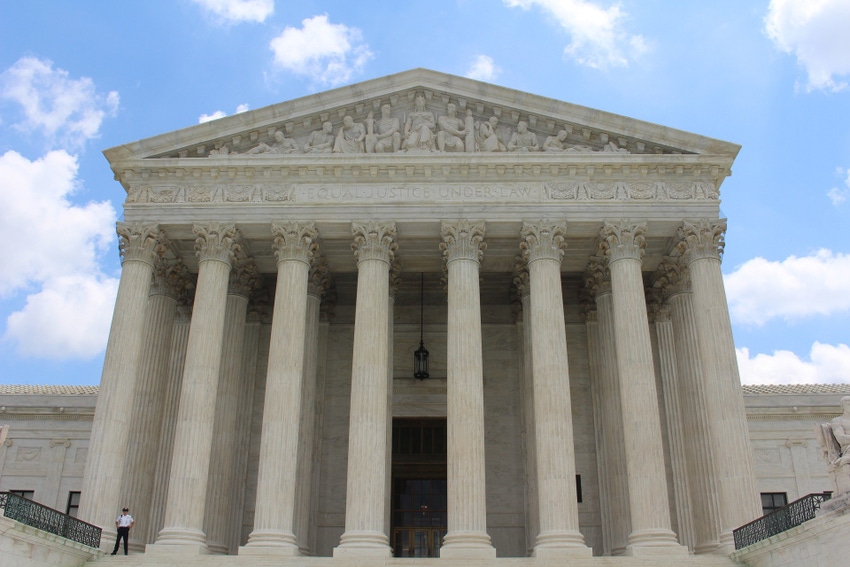SCOTUS to hear WOTUS case
Property owners challenge EPA’s overreach on navigable waters in wetlands determination.

The U.S. Supreme Court has decided to hear a case involving “waters of the United States” that stems from a 2004 order from the U.S. Environmental Protection Agency stopping Michael and Chantell Sackett from building on their land because of the presence of “wetlands.” The Idaho couple were told they needed a Clean Water Act permit to build a home on their private property, even though the lot they were building on lacked a surface water connection to any stream, creek, lake or other water body.
In Sackett vs. EPA, the U.S. Supreme Court will be determining whether the 9th Circuit used the proper tests in determining whether wetlands were “waters of the United States” under the Clean Water Act.
In 2004, the Sacketts bought a vacant lot near Priest Lake, Idaho, and obtained local permits to build a home. But when the Sacketts started the construction process, the EPA suddenly ordered them to stop work, and, months later, sent the Sacketts a compliance order claiming the property contained a wetland that could not be filled without a federal permit.
EPA prohibited the Sacketts from constructing their home, demanded costly restoration work, and required a three-year monitoring program, during which the property was to be left untouched. The agency also threatened the Sacketts with fines of up to $75,000 per day if they didn’t obey the order.
The order denied the Sacketts the right to use their property, and the agency argued that they had no right to challenge the order in court. Represented by Pacific Legal Foundation, the Sacketts argued that it was unlawful to deny them a judicial hearing. They were vindicated when the U.S. Supreme Court ruled in their favor in 2012, confirming their right to contest the order.
American Farm Bureau Federation President Zippy Duvall welcomed the court's decision to offer additional clarity on what constitutes a "waters of the U.S." under the Clean Water Act. "Farmers and ranchers share the goal of protecting the resources they’re entrusted with, but they shouldn’t need a team of lawyers to farm their land. We hope this case will bring more clarity to water regulations," Duvall says.
Duvall also adds, in light of the action, AFBF called on EPA to "push pause on its plan to write a new WOTUS rule until it has more guidance on which waters fall under federal jurisdiction." EPA currently has a comment period open until February 7 on its proposed rule.
For nearly a decade since, the Sacketts have been in court battling with the EPA over their interpretation of the Clean Water Act, PLF says.
In a 2006 PLF case, Rapanos v. United States, the Supreme Court ruled to limit EPA’s regulatory power, but the agency has attempted to sidestep the ruling by issuing guidance documents and creating new rules, like the 2015 Waters of the United States rule and the 2020 Navigable Waters Protection Rule. Each change has also been met with lawsuits, and courts have applied the 2006 case unevenly.
“The result is a confusing patchwork of regulations that are inconsistent across the country,” PLF says.
Now the Sacketts have asked the Supreme Court to clarify what EPA can regulate under the clean water act and what it cannot.
“Although EPA withdrew its compliance order and its past threats of massive fines, it maintains that it has the power to regulate the Sacketts’ property. If the Sacketts’ property can be regulated by the federal government, so too can the properties of other homeowners, farmers, and businesses that are engaging in non-harmful activities,” PLF says.
Rapanos ruling impact
Back in 1989, Michigan developer John Rapanos was simply clearing his property to build homes and a shopping mall when he became so ensnared in a regulatory quagmire, it took the U.S. Supreme Court to resolve.
In 1995, a U.S. District Court jury convicted John of destroying federally regulated wetlands. His punishment came three years later; $185,000 in fines and a sentence of three years’ probation and 200 hours of community service.
Represented by PLF, Rapanos battled all the way to the U.S. Supreme Court, where he won in 2006. In their divided decision, a majority ruled that the EPA’s and the Army Corps’ regulations defining “navigable waters” were illegal and ordered the case back to the lower courts, which ultimately reached a settlement with him.
While the Rapanos ruling established limits to federal authority over non-navigable waters, it fell one vote short of a definitive guideline for what the EPA and the Corps can—and cannot—regulate under the CWA.
Four Justices issued a new, clear and reasonable regulatory standard for navigable waters that requires a continuous surface water connection between wetlands and a regulated water. Justice Kennedy, however, devised a vague and broad “significant nexus” test. The inclusion of a “significant nexus” was included in the 2015 Obama rule, and again appears to be part of the discussion in the Biden administration’s attempt to rewrite the rule.
PLF explains with lower courts left to decide what to do, Rapanos has led to much confusion and continued agency overreach; neither the lower courts, nor the agencies, nor the regulated public can agree on what the rule of Rapanos is, much less on how to apply any such rule efficiently and consistently.
The Sacketts of Idaho became one of the EPA’s earliest post-Rapanos enforcement targets in 2007 and have been fighting the government ever since. On behalf of the Sacketts, PLF has asked the Supreme Court to vindicate their property rights and restore with finality the proper judicial application of the Rapanos win.
About the Author(s)
You May Also Like





